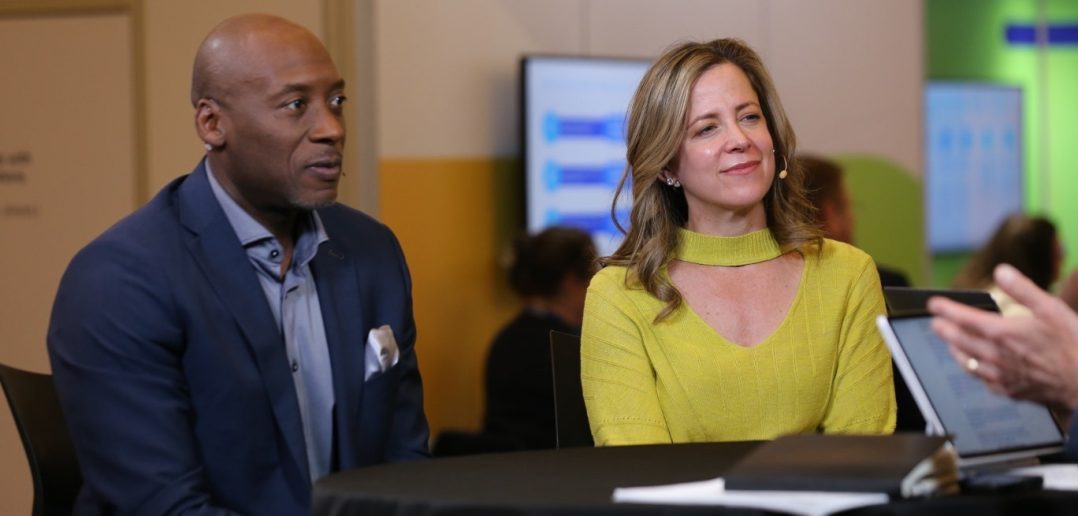Step into the vibrant, insightful platform that is theCUBE, where industry leaders don’t just talk tech; they unpack AI’s impact on our world.
Eight quotes aren’t enough to describe all the knowledge shared by SAS leaders during theCUBE’s session at SAS Innovate 2024. But this blog post would go on forever if I shared everything insightful. So, these eight quotes aim to encapsulate the topics discussed and shed light on key themes and challenges regarding AI.
Is AI “hella hard or doable”?
John Furrier, co-host of theCUBE Podcast, asked SAS Vice President of Data Ethics Practice Reggie Townsend one of my favorite questions of the event. Ultimately, whether AI is “hella hard or doable” was about the challenge of AI innovation as the world rapidly changes.
Townsend’s take? It’s all about eating the elephant one bite at a time, starting with clear definitions and acknowledging that what’s ethical today may not hold tomorrow.
“Now, the reality is that right and wrong are always going to be a function of time,” Townsend said. “What might work now may not work five years from now. And so, looking at that from a longitudinal view will be important.”
Townsend, along with Miriam Vogel, President and CEO of EqualAI, also discussed the need for nuanced approaches, especially in highly regulated sectors like pharmaceuticals, finance and law enforcement. It’s that balancing act that Townsend often talks about, which requires exploring AI’s potential while mitigating risks.
Making a move to the cloud
Many organizations have been eager to embrace the cloud and its capabilities, but some aren’t ready for a complete migration. Some can seamlessly transition, while others may need a phased approach.
For that, SAS Chief Information Officer Jay Upchurch shared a few strategies for migrating customers to the cloud. When asked about the approach in a conversation with Furrier and Sri Raghavan, Principal Technology Partnerships Data Analyst at Amazon Web Services, he offered these four nuggets:
- Tailor strategies to each customer’s needs.
- Offer “lift and shift” or “lift and modernize” options.
- Accommodate different migration paces.
- Guide customers along safely.
“We try to meet our customers where they are in their cloud journey,” Upchurch said. “The good news is we’re a couple of years into this. We’ve learned a lot as we’ve gone, so our ability to get our customers there safely so we can de-risk the move has been key to our success and frankly, our customers’ success.”
Exploring the power of SAS® Viya® Workbench
SAS Viya Workbench is a flexible and easy-to-use cloud computing environment. It’s a toolbox containing everything developers need with open-source tools such as Visual Studio Code and Jupyter Lab.
This is a big deal for developers and SAS users. Senior Vice President of Research and Development Jared Peterson gave listeners the scoop on its many capabilities.
Peterson also said Workbench is “the leanest, meanest rendering of the Viya platform.”
“We’ve taken out everything you don’t need for this pure developer, SAS and Python coder persona, and we’ve just leaned it out. It starts up in seconds and runs super fast,” Peterson said.
Quantum computing’s “GenAI moment”
After eating blazing hot wings, SAS Chief Technology Officer Bryan Harris discussed quantum computing and its future.
Harris highlighted GenAI's limitations in quantitative reasoning and pointed out that quantum computing's strengths in tackling complex optimization problems could help advance GenAI. Quantum computing's ability to process multiple states simultaneously enables it to solve combinatorial problems faster and more efficiently.
Speaking of GenAI, Harris believes that quantum computing will have its “GenAI moment.”
“The market is showing a lot of progression. It’s a $35 billion market, but it is projected to reach a trillion dollars by 2030,” Harris said. So, you’ve got to imagine what’s happening in the next six years—the leaps we’ll make in this.”
According to Harris, industries like life sciences, banking and government stand to benefit from quantum computing’s capabilities in optimizing processes and reducing computational costs.
AI and automation in the workforce
A study conducted by the Boston Consulting Group and Harvard Business School aimed to highlight variability in the ability to use AI tools effectively. This study made a chatbot trained in domain knowledge available to business analysts. The study found that while overall productivity increased, the primary beneficiaries were less experienced analysts. Interestingly, more experienced analysts experienced a decrease in productivity.
SAS Advisory Business Solutions Manager Kimberly Nevala discussed this study and its examples of AI and automation's impact on the workforce.
To combat future iterations of the Boston Consulting Group study results, Nevala challenged leaders to find strategies to balance AI use and nurturing human skills and creativity.
“The new leadership challenge is not how we manage the business when all of these tasks and roles, but probably more tasks, have been migrated to AI,” Nevala said. “It's now how do I operate the business in such a way that I look at my humans as a resource and I provide them development opportunities, and that I'm actively engaging and thinking about if AI is doing these things, what is the next job that I can apply this person to do?"
The importance of being output-driven
Exploring the evolving trends in AI, SAS Vice President of Applied AI and Modeling Udo Sglavo discussed how SAS distinguishes itself by being more output-driven. According to Sglavo, this approach is a key differentiator for SAS.
“One thing that separates SAS from many of our competitors is that we like to be output-driven,” Sglavo said. So, we think about the output and the decision first: What are we trying to accomplish? And then we think about which technology, which mode from these different universes, text streaming data images, is required to address that problem.”
By focusing on the desired outcomes from the outset, SAS ensures that the most relevant data types and technologies are selected to achieve specific goals. This method also ensures that every decision is purposefully driven by the end objective.
Overcoming AI adoption challenges in finance
Financial institutions need help adopting AI effectively due to hurdles such as data quality, biases and downstream consequences of decisions. Despite the growing awareness and intent to adopt AI, the adoption rate still needs to grow.
Senior Vice President of Risk, Fraud and Compliance Solutions Stu Bradley highlighted these challenges. He emphasized the need for financial institutions to use AI to automate tasks, drive efficacy in operational processes and provide a more rewarding experience for employees.
Bradley asked, “How do we automate mundane human tasks and make them more efficient but rewarding employee experiences?”
Bradley also discussed GenAI's role in automating investigative tasks. It could help investigators focus more on analyzing suspicious activities and addressing fraud.


